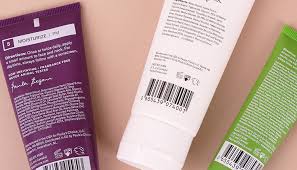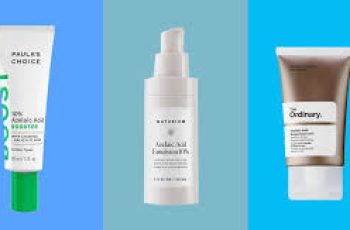
Ingredients on skin care product labels
The ingredients listed on skin care product labels are standardized for clarity. All skin care products are required use International Nomenclature Cosmetic Ingredient names (INCI names) when listing ingredients on product labels.
How do you list ingredients on a skin care label?
Skin care ingredients are placed in order on product labels by their predominance; this means the ingredient that makes up the highest percentage of the product is listed first.
Each subsequent listed ingredient is used less than the one before it on the label. This is the same regulation seen in food products.
The ingredient that makes up the lowest percentage of the total volume of a product is listed last on the product label.
What are INCI names on cosmetic products?
International Nomenclature Cosmetic Ingredient names, known as INCI, are internationally recognized names published in the International Cosmetic Ingredient Dictionary and Handbook. They are the names found on product labels.
They were developed in the 1970s by the Cosmetic, Toiletry and Fragrance Association (Now called the Personal Care Council) to standardize the nomenclature and increase transparency for consumers.
INCI names are recognized by the U.S. Food and Drug Administration as the labeling names that must be used for cosmetic ingredient labeling under U.S. regulation 21 CFR 701.3.
Are INCI names used in every country or just the USA?
Many other countries such as the European Union, China and Japan require the use of INCI names as well. This means that product labels should be consistent between countries.
Why INCI names are important
International Nomenclature Cosmetic Ingredient (INCI) names are crucial on skincare product labels because they establish a standardized and transparent system for ingredient identification. This consistency allows consumers, professionals, and regulators globally to easily recognize and understand the components of a particular product, regardless of language or regional differences. By using INCI names, manufacturers communicate the content of their products in a universally comprehensible manner. This standardization is especially vital in the skincare industry, where ingredient sensitivities and allergies are prevalent. Consumers can make informed choices about what they are applying to their skin, ensuring safety and avoiding potential adverse reactions. Additionally, with the increasing demand for transparency in the beauty and personal care industry, INCI labeling empowers consumers to identify ingredients they may wish to avoid due to ethical, environmental, or health concerns. In essence, INCI names on skincare product labels foster clarity, safety, and informed decision-making for consumers worldwide.
Why are INCI names used on product labels?
Using INCI names on product labels allows dermatologists and others in the medical community and beauty industry to more precisely share information regarding ingredients. When medical professionals use the same names for the same ingredients makes it easier to research details like adverse reactions or side effects.
Scientists are ensured that information on ingredients from scientific and other technical publications will be referenced under the same name; and that multiple names for the same material will not lead to confusion.
INCI names on product labels also enable the cosmetic industry to track the safety and the regulatory status of ingredients efficiently worldwide. Regulations like INCI names enhance the industry’s ability to market safe products that meet various national regulations.
Ingredient names used to vary internationally and would be called different things in different countries. This made it hard to read product labels and buy with confidence. Standardizing cosmetic ingredient nomenclature with the use of INCI names on product labels solved these issues.
How ingredients on skin care products get their names
Cosmetic ingredient names are primarily determined using the International Nomenclature of Cosmetic Ingredients (INCI) system. Here’s a brief overview of how these names are chosen:
Standardized Naming Conventions: The INCI system follows specific rules and conventions for naming ingredients. This ensures consistency across products and countries.
Botanical Ingredients: For ingredients derived from plants, the Latin binomial name (genus and species) is typically used. For instance, the oil derived from the sunflower seed would be labeled as “Helianthus Annuus (Sunflower) Seed Oil.”
Chemical Compounds: Chemical ingredients are typically named using recognized chemical nomenclature, either from IUPAC (International Union of Pure and Applied Chemistry) or common chemical names. For instance, water is labeled as “Aqua.”
Trade Names vs. INCI Names: While companies may have a trade name for a specific ingredient or blend, the INCI name must still be listed on the product label for clarity and transparency. For instance, a company might use a trade name like “HydraBoost” for a specific hyaluronic acid formulation, but the ingredient list would still include “Sodium Hyaluronate” (the INCI name for a form of hyaluronic acid).
Complex Mixtures: For some ingredients that are complex mixtures and don’t fit traditional naming systems, special names may be developed for INCI labeling.
Adoption and Updates: The Personal Care Products Council (PCPC) in the U.S. manages the INCI naming process. Manufacturers can submit new ingredients to the PCPC for review, and if accepted, the new ingredient name gets added to the INCI dictionary. The INCI list is updated regularly to account for new ingredients and scientific advancements.
The objective behind these standardized naming conventions is to ensure clarity, consistency, and transparency in cosmetic labeling, allowing consumers to quickly understand and identify the ingredients used in their personal care products, irrespective of where they are manufactured or purchased.
Which INCI names to look for on product labels to find the right products for your skin type?
Take the skin care routine quiz
See our custom skin care routine suggestions
Search our comprehensive skin care ingredient library by INCI name and look for your skin type octagon on products right for you.


